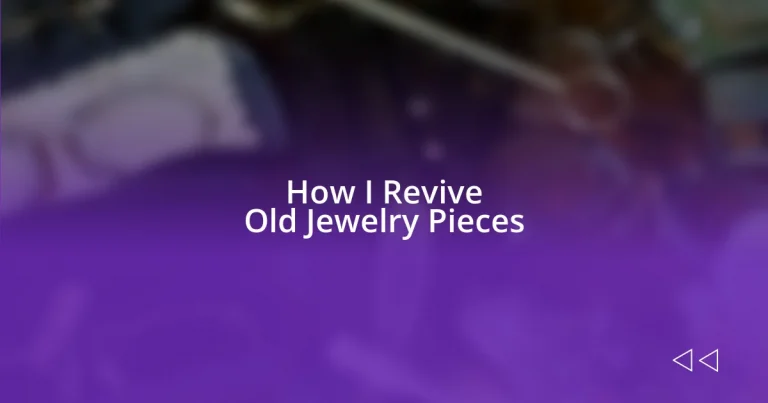Key takeaways:
- Assess the physical and emotional condition of jewelry before cleaning or restoring, as both aspects enhance the revival process.
- Choose appropriate cleaning methods based on the type of material and gemstones to ensure their safety and longevity.
- Enhance the aesthetic appeal of old jewelry through creative combinations and thoughtful layering, connecting pieces to specific outfits or occasions.
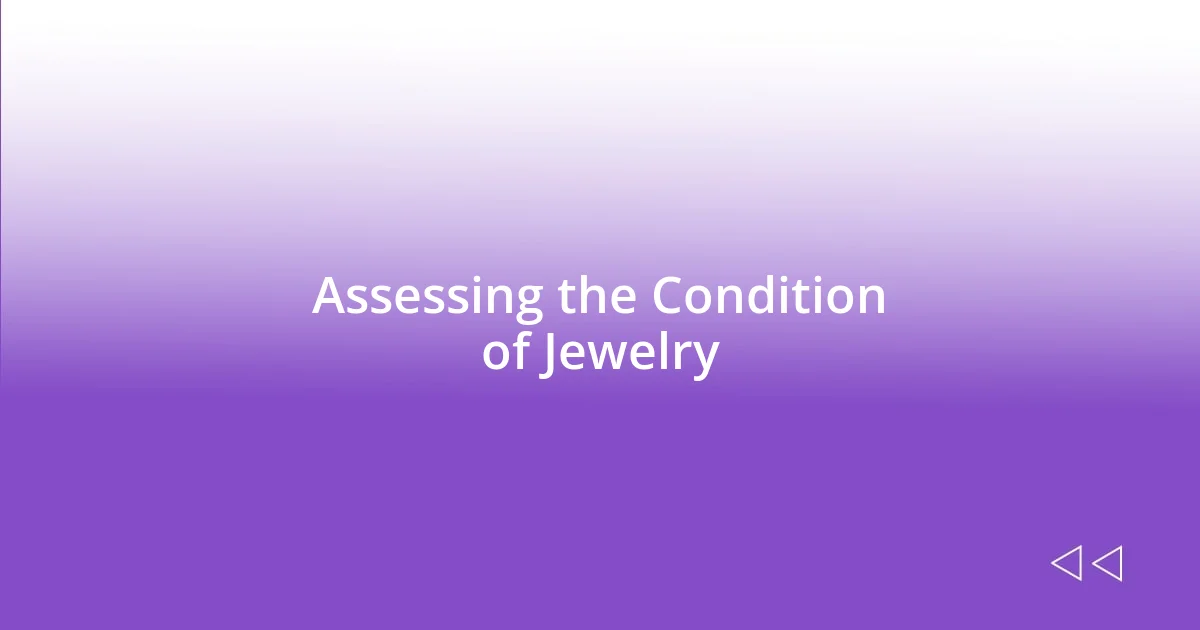
Assessing the Condition of Jewelry
When I first began revisiting my old jewelry, I found myself enchanted by the stories each piece told. The first thing I noticed was how important it is to examine for any visible signs of wear, like scratches or tarnish. Have you ever found a piece that seems forgotten, only to realize the magic it holds once you take a closer look?
I often gently clean each item with a soft cloth to appreciate its brilliance under a new light. With vintage pieces, you might encounter loose stones or broken clasps that require your attention. I remember the thrill I felt when I discovered a beautiful brooch—once tarnished—shining with all its glory after just a little TLC.
As I assess each piece, I also look for the emotional connection it holds. Does it remind you of a special time or person in your life? This aspect often influences how much effort I’m willing to invest in reviving it. By examining both the physical state and the emotional significance, I ensure that the revival is meaningful, not just cosmetic.

Choosing the Right Cleaning Methods
Choosing the right cleaning method for your old jewelry can be a bit like selecting a favorite recipe—different pieces require different approaches. I recall a delicate silver necklace that had accumulated a layer of tarnish over the years. Initially, I was unsure whether to plunge it into a commercial cleaner or use a gentle homemade solution. Ultimately, I decided to make a paste with baking soda and water, applying it with a soft cloth. The end result was stunning, and I felt like I had brought back a piece of history.
Here are some cleaning methods based on the type of jewelry:
- For gold and silver: Use a mixture of warm water and mild soap, followed by a soft cloth for drying.
- For gemstones: Start with a gentle soap solution; avoid harsh chemicals that could damage them.
- For pearls: Wipe with a damp cloth and avoid soaking; they require special care to maintain their luster.
- For costume jewelry: Often a simple wipe with a soft cloth can restore their shine; be cautious with water.
Understanding these methods not only helps to rejuvenate your treasures but also deepens the bond you share with each piece. I always feel a little spark of joy each time I see a reflection of my efforts—a tangible reminder of the memories tied to those pieces.
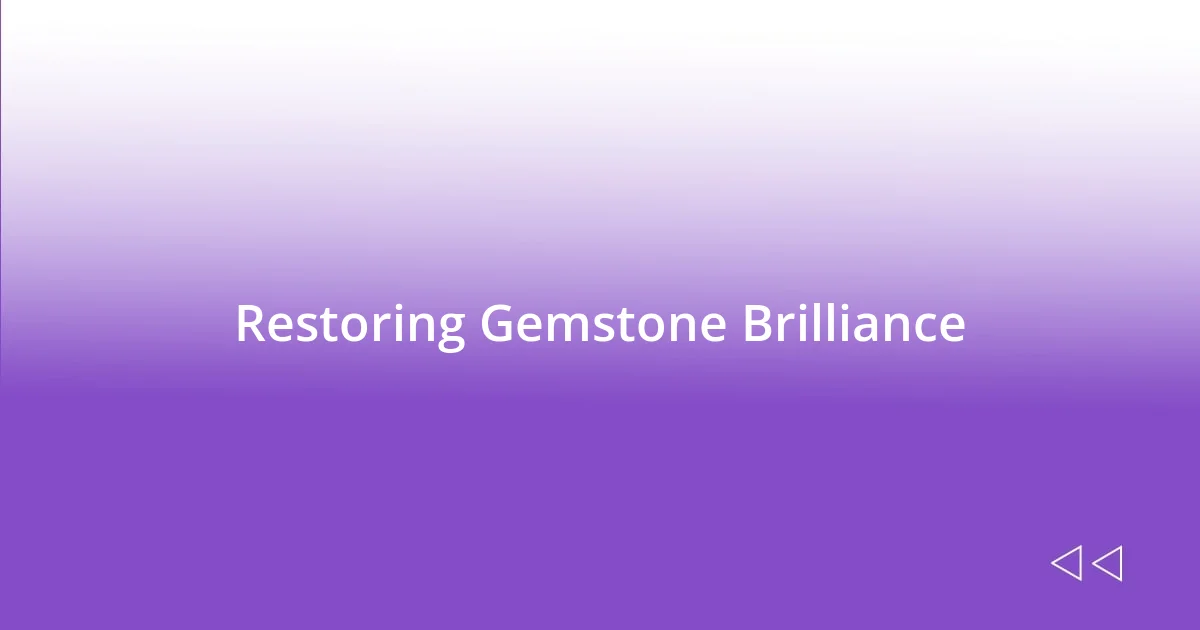
Restoring Gemstone Brilliance
Restoring the brilliance of gemstones can be a truly rewarding experience. I remember inheriting a stunning amethyst ring from my grandmother that had lost its sparkle over the years. With a gentle approach, I soaked it in a mild soap solution, carefully brushing the stone with a soft toothbrush. That moment when the light caught the amethyst just right, revealing deep purples and stunning clarity, filled me with nostalgia and a sense of connection to my family’s history.
It’s essential to know which gemstones require special attention. For example, delicate stones like opals and pearls can easily become damaged if treated like more durable gems such as diamonds or rubies. Honestly, the first time I made that mistake with a beautiful opal pendant, it was disheartening! Now, I always research gemstone care to avoid unnecessary mishaps and to ensure I’m providing each piece the love and consideration it deserves.
Cleaning isn’t just practical; it can be deeply personal too. I often find myself reminiscing about the moments attached to each gemstone. Just last month, I revived a lovely turquoise bracelet that had faded from the sun’s rays. As I polished it, memories of sunny beach days and laughter flooded back. Restoring gemstone brilliance is about more than aesthetics; it’s about rekindling those emotional connections that make these pieces invaluable.
| Gemstone Type | Cleaning Method |
|---|---|
| Diamonds | Soak in warm water with mild soap, gently brush with a soft brush |
| Emeralds | Use a soft cloth; avoid soaking, as they often contain oil |
| Rubies | Soak in gentle soap solution and clean with a soft brush |
| Opals | Wipe with a damp cloth; never soak, as it can ruin their luster |
| Pearls | Wipe with a damp cloth; avoid harsh detergents or soaking |
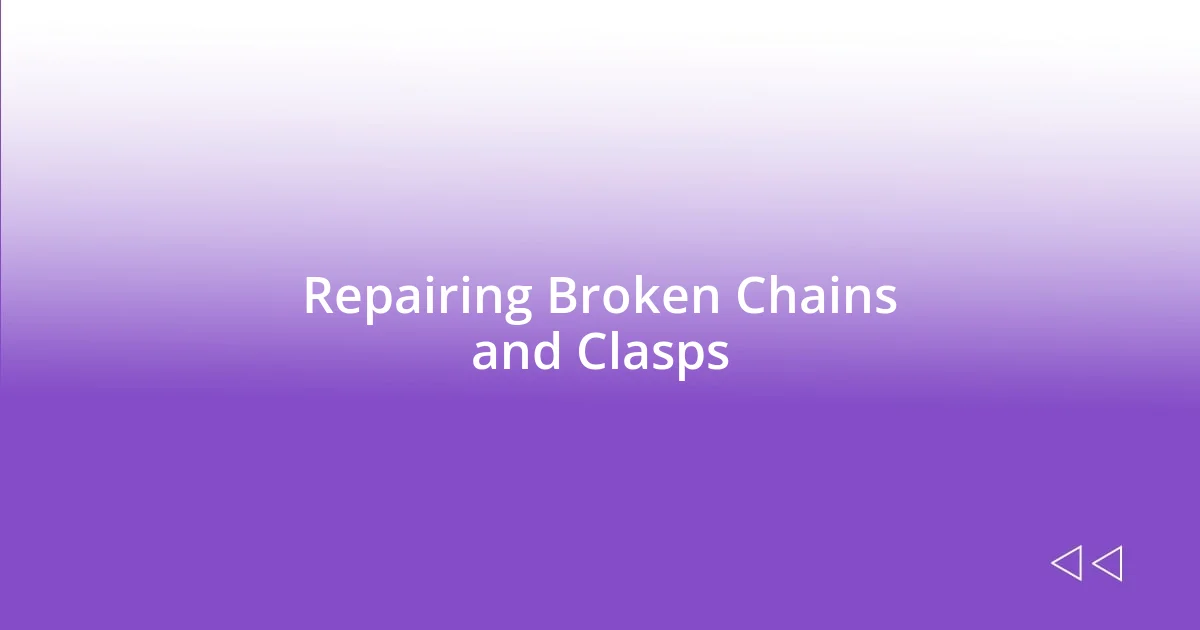
Repairing Broken Chains and Clasps
Repairing broken chains and clasps can feel daunting, but it’s often simpler than it seems. I once encountered a delicate gold chain that had split right before an important event. Instead of panicking, I took a deep breath and grabbed some pliers. After carefully aligning the broken ends, I used a jump ring to connect them. That little fix transformed my anxiety into a sense of triumph, reminding me how even small efforts can rescue cherished pieces.
When it comes to clasps, I’ve discovered that replacing a faulty clasp can breathe new life into an otherwise neglected necklace. I remember revitalizing an antique locket that had been sitting in my jewelry box for ages. The clasp was weak, causing it to open unexpectedly. By swapping it out for a sturdy lobster clasp, I gave the locket a fresh lease on life. Now, every time I wear it, I feel a renewed attachment as I confidently secure it without worry.
Have you ever thought about how much a well-functioning clasp contributes to the overall experience of wearing jewelry? I’ve certainly pondered that while reconnecting a favorite bracelet that had been collecting dust due to a missing clasp. With a quick repair, I not only restored the bracelet but also reclaimed the memories tied to it—like the adventures I had while wearing it. It’s moments like these that highlight how jewelry repairs can do more than just fix; they can rekindle the stories and emotions intertwined with our treasured pieces.
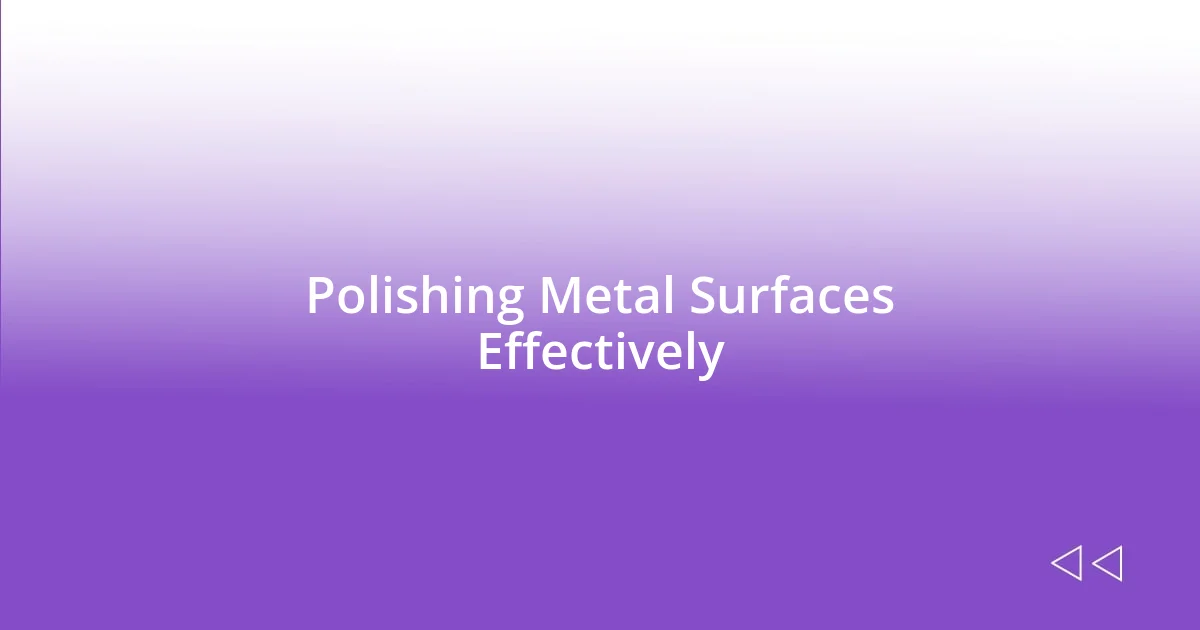
Polishing Metal Surfaces Effectively
Polishing metal surfaces can truly transform neglected pieces into shining treasures. I vividly recall the first time I tackled a tarnished silver necklace from my travels. Armed with a soft cloth and some silver polish, I gently rubbed away the dullness. As the gleam emerged, it reflected not just the metal’s shine but also the memories of that trip. Have you ever noticed how a little polish can evoke joy tied to experiences?
I’ve learned that using the right technique is essential for effective polishing. For instance, I discovered that a back-and-forth motion is more effective than circular strokes when working with delicate pieces. This was particularly true for a pair of vintage earrings I almost ruined by being too aggressive. Now, I take my time, allowing the polish to work its magic gradually. This patience has led me to countless gleaming reunions with my jewelry collection.
The choice of polish is equally important. I often experiment with DIY options, like a mixture of baking soda and water. I remember how pleasantly surprised I was when this method brought back the shine to a brass bracelet that seemed beyond hope. Engaging with the polishing process can be meditative; it connects me to each piece, transforming what could be a chore into a cherished ritual. Don’t underestimate the power of a good polish—it’s not just about the end result but the journey of revival.

Enhancing Aesthetic Appeal
Reviving the aesthetic appeal of old jewelry often involves adding a touch of creativity beyond just polishing. One of my favorite methods is to pair a vintage brooch with a modern chain, creating a unique necklace that feels both fresh and timeless. I remember the thrill of taking a delicate crystal brooch from a flea market and combining it with a sleek, gold chain—suddenly, it became a conversation starter. Have you ever thought about how a simple change can turn a forgotten piece into a statement accessory?
Another way to enhance aesthetics is through thoughtful layering. I love experimenting with layering different bracelets, as it allows me to highlight contrasting textures and colors. I once combined a chunky wooden bracelet with a thin, shimmering one, and the result was a stunning fusion of natural and elegant vibes. Can you imagine the surprises that simple combinations could unveil in your jewelry collection?
Don’t overlook the importance of matching your jewelry with different outfits or occasions. The last time I wore a silk dress to a family gathering, I opted for a vintage pair of pearl earrings that perfectly complemented the fabric’s elegance. It made me feel more connected to the piece, reflecting the occasion’s spirit. How often do you consider the relationship between your jewelry and your wardrobe? In my experience, this consideration not only enhances the jewelry’s appeal but also deepens the sentiment attached to each piece as they take on new roles in our lives.











